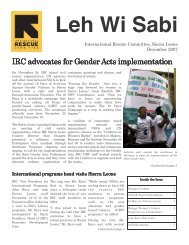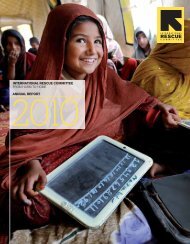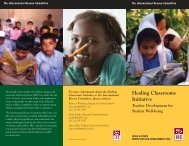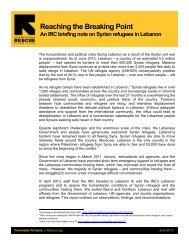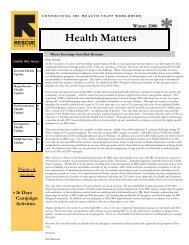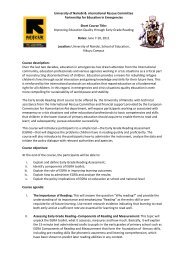Fourteen percent <str<strong>on</strong>g>of</str<strong>on</strong>g> survey resp<strong>on</strong>dents said they havec<strong>on</strong>sidered dropping out <str<strong>on</strong>g>of</str<strong>on</strong>g> school but d<strong>on</strong>‟t think [they]would do it, while <strong>on</strong>e resp<strong>on</strong>dent reported that he or she isthinking about dropping out.“I have two s<strong>on</strong>s that came to America <strong>on</strong> a[Diversity Visa] <str<strong>on</strong>g>and</str<strong>on</strong>g> all was well until theywere introduced to the school system.Everything started going wr<strong>on</strong>g, the boyswere failing in their school work, cominghome late, <str<strong>on</strong>g>and</str<strong>on</strong>g> at <strong>on</strong>e point they refused togo to school. This was due to the fact thatthey could not underst<str<strong>on</strong>g>and</str<strong>on</strong>g> the less<strong>on</strong>s, theteacher called them names, <str<strong>on</strong>g>and</str<strong>on</strong>g> otherstudents bullied them <str<strong>on</strong>g>and</str<strong>on</strong>g> so <strong>on</strong>”. 51Figure 20Why do most youth drop out <str<strong>on</strong>g>of</str<strong>on</strong>g> school?Number selecting yes (out <str<strong>on</strong>g>of</str<strong>on</strong>g> 107 who answered the questi<strong>on</strong>)71BadInfluences42 41 38Not Want tointerested in make m<strong>on</strong>eyschoolworkNot enoughsupport athome26Not enoughsupport atschool12Other“Remember, when you put a 5th gradestudent in the 9th grade you do not expectmuch out <str<strong>on</strong>g>of</str<strong>on</strong>g> him. But the kids do not see itthat way… If you were to ask that kid to reada 9th grade book he may not be able to doso. And if he does it, he might not do it thesame as a regular ninth grader… Other kidsin the class [start] to laugh at him, callinghim names. <str<strong>on</strong>g>The</str<strong>on</strong>g> next thing you know the kiddoes not want to go to school any more. Hemay leave his parents‟ home in the morningwith the pretense that he is going to schoolbut he doesn't. He hangs <strong>on</strong> the streetswith friends… <str<strong>on</strong>g>and</str<strong>on</strong>g> comes home as if hecame from school. It wouldn't be l<strong>on</strong>g beforethis kid starts selling <str<strong>on</strong>g>and</str<strong>on</strong>g> doing drugs. Bythe time you as a parent realize what he isdoing, it may be too late. He may havejoined the Gang. How do you try to help yourChild with these problems?” 52Asset: Educati<strong>on</strong> supportsThough there are too few, some services are available forstudents whose educati<strong>on</strong> has been interrupted. <str<strong>on</strong>g>The</str<strong>on</strong>g>Students with Interrupted Formal Educati<strong>on</strong>, or SIFE,program is funded by the New York City Department <str<strong>on</strong>g>of</str<strong>on</strong>g>Educati<strong>on</strong> to help students acclimate <str<strong>on</strong>g>and</str<strong>on</strong>g> catch up to theirpeers. In 2008, IS 49 Bertha A. Dreyfus (middle school) isthe <strong>on</strong>ly <strong>Staten</strong> Isl<str<strong>on</strong>g>and</str<strong>on</strong>g> school with this program. 53Recognizing the need for improved relati<strong>on</strong>s with the <str<strong>on</strong>g>African</str<strong>on</strong>g>community, many teachers, principals, <str<strong>on</strong>g>and</str<strong>on</strong>g> other schoolpers<strong>on</strong>nel have taken the initiative to get involved withcommunity organizati<strong>on</strong>s <str<strong>on</strong>g>and</str<strong>on</strong>g> collaborative initiatives. Thishas improved the capacity <str<strong>on</strong>g>of</str<strong>on</strong>g> local schools to educate<str<strong>on</strong>g>African</str<strong>on</strong>g> youth <str<strong>on</strong>g>and</str<strong>on</strong>g> opened lines <str<strong>on</strong>g>of</str<strong>on</strong>g> communicati<strong>on</strong> to parents<str<strong>on</strong>g>and</str<strong>on</strong>g> community advocates.51 Parent focus group, October 8, 2008.52 Parent interview, October 9, 2008.53 New York City Department <str<strong>on</strong>g>of</str<strong>on</strong>g> Educati<strong>on</strong>, Summary <str<strong>on</strong>g>of</str<strong>on</strong>g> School Allocati<strong>on</strong>,Memor<str<strong>on</strong>g>and</str<strong>on</strong>g>um No. 65, FY08.28
Issue: Few opportunities for c<strong>on</strong>structive activitiesduring out <str<strong>on</strong>g>of</str<strong>on</strong>g> school timeBey<strong>on</strong>d school youth have little access to resources <str<strong>on</strong>g>and</str<strong>on</strong>g>opportunities for structured, productive, asset-buildingactivities.Most youth are limited to their immediate community to findopportunities as the <str<strong>on</strong>g>African</str<strong>on</strong>g> community is relatively isolated<str<strong>on</strong>g>and</str<strong>on</strong>g> <str<strong>on</strong>g>African</str<strong>on</strong>g> parents (especially those living in Park Hill) <str<strong>on</strong>g>of</str<strong>on</strong>g>tendo not like or feel comfortable traveling far. Few parents c<str<strong>on</strong>g>and</str<strong>on</strong>g>rive their children to <str<strong>on</strong>g>and</str<strong>on</strong>g> from activities. Many youth rely <strong>on</strong>public buses (which they may not be able to afford regularly)or walking (which is not always safe).Neither parents nor youth are well informed <str<strong>on</strong>g>of</str<strong>on</strong>g> whatprograms <str<strong>on</strong>g>and</str<strong>on</strong>g> opportunities are available. Many indicatedthere is nothing for teens to do afterschool for recreati<strong>on</strong> orjob-training, homework help, SAT or other exam preparati<strong>on</strong>.Some youth also indicated they do not underst<str<strong>on</strong>g>and</str<strong>on</strong>g> how toaccess higher educati<strong>on</strong>, especially without a high gradepoint average <str<strong>on</strong>g>and</str<strong>on</strong>g>/or ability to pay.<str<strong>on</strong>g>The</str<strong>on</strong>g>re are relatively few youth programs. <str<strong>on</strong>g>The</str<strong>on</strong>g> Figure 22compares the services <str<strong>on</strong>g>and</str<strong>on</strong>g> programs available <str<strong>on</strong>g>and</str<strong>on</strong>g> thedesire youth surveyed expressed for different types <str<strong>on</strong>g>of</str<strong>on</strong>g>programs.Several organizati<strong>on</strong>s <str<strong>on</strong>g>of</str<strong>on</strong>g>fer similar services, <str<strong>on</strong>g>and</str<strong>on</strong>g> many aretrying to do so <strong>on</strong> very small budgets. <str<strong>on</strong>g>The</str<strong>on</strong>g> most widelyavailable services fall under counseling/discussi<strong>on</strong>,informati<strong>on</strong> & referral provisi<strong>on</strong>, academic support, <str<strong>on</strong>g>and</str<strong>on</strong>g>visual arts. Though five organizati<strong>on</strong>s‟ resp<strong>on</strong>ded they <str<strong>on</strong>g>of</str<strong>on</strong>g>fervocati<strong>on</strong>al skills training four <str<strong>on</strong>g>of</str<strong>on</strong>g> the five resp<strong>on</strong>ses were“cooking/home ec<strong>on</strong>omics” <str<strong>on</strong>g>and</str<strong>on</strong>g> <strong>on</strong>e was medical billing.Clear gaps exist to meet dem<str<strong>on</strong>g>and</str<strong>on</strong>g> for sports, vocati<strong>on</strong>al skilldevelopment, <str<strong>on</strong>g>and</str<strong>on</strong>g> m<strong>on</strong>ey management. In additi<strong>on</strong>, feworganizati<strong>on</strong>s have licensed teachers as tutors or homeworkhelpers, <str<strong>on</strong>g>and</str<strong>on</strong>g> many <str<strong>on</strong>g>of</str<strong>on</strong>g> the counseling services provided areinformal (not provided by a licensed social worker). Severalorganizati<strong>on</strong>s indicated that they would hire qualifiedteachers <str<strong>on</strong>g>and</str<strong>on</strong>g> social workers if they had the budget to do so.Furthermore, 43 percent <str<strong>on</strong>g>of</str<strong>on</strong>g> resp<strong>on</strong>ding organizati<strong>on</strong>s saidstaff or volunteers normally provide informati<strong>on</strong> or services<strong>on</strong> reproductive health topics (such as HIV/AIDS, STIs,family planning/c<strong>on</strong>tracepti<strong>on</strong>, <str<strong>on</strong>g>and</str<strong>on</strong>g> pregnancy). Seventy-ninepercent said they provide informati<strong>on</strong> or services regardingphysical health (such as health <str<strong>on</strong>g>and</str<strong>on</strong>g> safety, drugs <str<strong>on</strong>g>and</str<strong>on</strong>g>alcohol, exercise <str<strong>on</strong>g>and</str<strong>on</strong>g> nutriti<strong>on</strong>, <str<strong>on</strong>g>and</str<strong>on</strong>g> physical educati<strong>on</strong>).Eighty percent said they provide informati<strong>on</strong> or services <strong>on</strong>parent/child communicati<strong>on</strong>.<str<strong>on</strong>g>Youth</str<strong>on</strong>g> Programs in the <strong>North</strong> <strong>Shore</strong><str<strong>on</strong>g>The</str<strong>on</strong>g> assessment identified 25 community-based organizati<strong>on</strong>s (notincluding schools) with youth services in the <strong>North</strong> <strong>Shore</strong>neighborhoods <str<strong>on</strong>g>of</str<strong>on</strong>g> Park Hill, Staplet<strong>on</strong>, Clift<strong>on</strong>, <str<strong>on</strong>g>and</str<strong>on</strong>g> St. George. Fiveprograms operate in Park Hill, including: <str<strong>on</strong>g>African</str<strong>on</strong>g> Refuge: drop in center, occasi<strong>on</strong>al after school program(target 30 youth) Catch a Falling Star: after school program (maximum 20 youth) Police Athletic League PlayStreets Program: Summer <strong>on</strong>ly (opento all) Roza Promoti<strong>on</strong>: computer center (capacity <str<strong>on</strong>g>of</str<strong>on</strong>g> approximately 25youth per day) <strong>Staten</strong> Isl<str<strong>on</strong>g>and</str<strong>on</strong>g> YMCA Counseling Service (various programs)29



